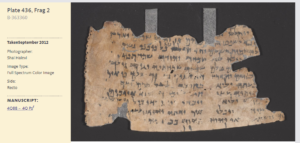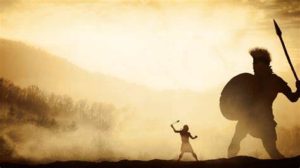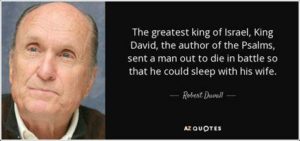Science and the Translation of Psalms 22
One verse in Psalms 22 creates a two-part controversy starting first with its translation difference between Christian and Jewish Bibles. That difference then leads to the next controversy, whether Psalms 22 is a foreshadowing or prophecy that foretells the crucifixion death of the Messiah.[1]
Christian Bible translations of Psalms 22:16 and Jewish Bibles Psalms 22:17 vary significantly. The differences are profound:
PS 22:16 “Dogs have surrounded me; a band of evil men has encircled me, they have pierced my hands and my feet.(NJKV)
PS 22:17 “For dogs have surrounded me; a band of evildoers has encompassed me, like a lion, my hands and feet.(CJB)
Handwritten on an ancient scroll, the difference is almost indistinguishable to the untrained eye without magnification.[2] In digital text, the difference is somewhat easier to see:
כארי
vs.
כארו
In Hebrew text, the slightest spelling variation can alter the entire meaning of a sentence, even changing a noun to a verb.[3] It is important to remember that Hebrew is written and read from right to left.
Taking special care not to miss such distinctions was even a challenge for the Rabbi authors of the Talmud:[4]
“R. Awira…as it is written [Prov. xxv. 21]: “If thy enemy be hungry, give him bread to eat, and if he be thirsty, give him water to drink; for though thou gatherest coals of fire upon his head, yet will the Lord repay it unto thee.” Do not read שלם (repay it), but שלים (he will make him peaceful toward thee).”
Jewish Bibles mostly translate the Hebrew word כארי (K’ari / Ka’ari) as “like a lion my hands and feet” with some translations reading “like lions [they maul] my hands and feet;” others “like a lion they are at my hands and my feet.”[5] All are meaningfully different from Christian Bibles based on the Hebrew word כארו (K’aru / Ka’aru) translated as “they have dug,” “pierced” or “pin.”[6]
Digging deeper, the root of the controversy lies with the age of the ancient Hebrew text source.[7] One Biblical text is over a millennium older than the other.
Septuagint LXX is the Hebrew-to-Greek standard translation accepted by Christianity dating to the period of 285-247 BC. According to Josephus, the translation was ordered by King Ptolemy of Egypt and performed by 72 Jewish scholars, 6 from each tribe, hence the Roman numeral “LXX”.[8]
Jewish Bibles are based on two surviving Hebrew Masoretic texts (MT), the Aleppo Codex dated to 925 AD and the Hebrew Leningrad Codex c. 1008-10 AD.[9] About a third of the Aleppo text has been missing since 1947 when a riot broke out in Aleppo, Syria, and the Synagogue holding the text was set ablaze.[10]
Modern Hebrew translations now have a dependency on the more recent Leningrad manuscript to fill in the missing content.[11] According to Menachem Cohen, Professor of Bible at Bar-Ilan University of Israel and director of the Miqraot Gedolot HaKeter Project, the Masoretic Text (MT) is the culmination of many variations of textual sources, spelling changes, and interpretations compiled into a final text.
Cohen stated that unlike the Septuagint, the MT lacked the benefit of a side-by-side comparison to the original “witnessing” Hebrew text. The Professor explained it this way: [12]
“…the aggregate of known differences in the Greek translations is enough to rule out the possibility that we have before us today’s Masoretic Text. The same can be said of the various Aramaic translations; the differences they reflect are too numerous for us to class their vorlage [original text] as our Masoretic Text.”
Using the science of textual criticism, Professor Cohen’s project team explained how the Masoretic text diverged from the 1250-year older Septuagint translation. The changes began at some point before the Roman’s destruction of the Jewish Temple in 70 AD:[13]
“In any case, it seems that after the destruction the array of text-types disappeared from normative Judaism, and the Masoretic type alone remained.”
“During the same period, new Greek translations were being prepared in place of the Septuagint, which, by virtue of its becoming an official Christian text, was rejected by the Jews. These translations, especially that of Aqilas which was praised by the Sages, reflected the Masoretic text-type.[14]
A Jewish rebellion against Rome from 132-135 AD, called the Bar-Kokhba revolt, was led by Simon ben Kochba, a rebel Jewish leader and military commander known for his strict adherence to traditional Jewish law.[15] A potentially game-changing scroll discovery made at that archeological site was described by Professor Cohen:
“In the fifties, remnants of Scriptural scrolls used by Bar Kochba’s soldiers were found in the Judean desert (Wadi Murabba’at and Nahal Hever). They all show that Bar Kochba’s people used the same text which we call the MT, with only the slightest of differences.”
Nahal (Nachal) Hever scrolls, as they are now called, are dated to the years between 2 BC – 68 AD predating the Leningrad Codex MT by about 1000 years, still some 200-300 years after the Septuagint LXX translation. Essentially coinciding with the lifetime of Jesus of Nazareth, the dating of these scrolls serve to dispel the charge of Christian manipulation of the Septuagint text to fit the Gospels written after the crucifixion of Jesus.[16]

One of the Nahal Hever scrolls surviving relatively intact is Psalms 22 where the potentially game-changing text uses the Hebrew word כארו (K’aru).[17] A translation of the Nehal Hever scroll from Psalms 22:14-18 translated by Dr. Martin Abegg Jr., Dr. Peter Flint and Eugene Ulrich reads:[18]
“[I have] been poured out [like water, and all] my bon[es are out of joint. My heart has turned to wax; it has mel]ted away in my breast. [My strength is dried up like a potsherd], and my tongue melts in [my mouth. They] have placed [me] as the dust of death. [For] dogs are [all around me]; a gang of evil[doers] encircles me. They have pierced my hands and feet. [I can count all my bones; people stare and gloat over me. They divide my garments among themselves and they cast lots for my] clothes.” * [19]
Archeological discovery of the Nahal Hever scroll with its translation corroborate the much older Septuagint text translation of Psalms 22:16(17), both bearing the Hebrew word כארו (K’aru), “they have dug,” “pierced” or “pin.”
Do these two text discoveries strengthen the view that Psalms 22:14-18 is a foreshadowing or prophecy of the Messiah’s manner of death?
Updated October 18, 2025.
* The words appearing in brackets were missing from the manuscript and have been supplied from other texts, if available. The words appearing in italics are those that differ from the later Masoretic text.
This work is licensed under a Creative Commons Attribution-NonCommercial-NoDerivatives 4.0 International License.
REFERENCES:
[1] Davidson, Paul. “A Few Remarks on the Problem of Psalm 22:16.” Is That in the Bible? 2015. <https://isthatinthebible.wordpress.com/2015/09/28/a-few-remarks-on-the-problem-of-psalm-2216> “Psalm 22.” Heart of Israel. n.d. <http://www.heartofisrael.net/chazak/articles/ps22.htm> <http://web.archive.org/web/20171016070503/http://www.heartofisrael.net/chazak/articles/ps22.htm> Barrett, Ruben. “Bible Q&A: Psalms 22.” HaDavar Ministries. 27 May 2008. Archived URL. Archive.org. 23 Aug. 2012. <http://web.archive.org/web/20120823025747/http://www.hadavar.net/articles/45-biblequestionsanswers/54-psalm22questions.html>
[2] Hegg, Tim. “Studies in the Biblical Text – Psalm 22:16 – “like a lion” or “they pierced”?” Torah Resource. 2013. <https://www.torahresource.com/EnglishArticles/Ps22.16.pdf>
[3] Fox, Tsivya. “Aleph, the First Hebrew Letter, Contains Depths of Godly Implications.” August 30, 2016. <https://www.breakingisraelnews.com/74824/adding-aleph-helps-bring-redemption> Benner, Jeff A. “Introduction to Ancient Hebrew.” Ancient Hebrew Research Center. 2019. <https://www.ancient-hebrew.org/introduction.htm> Benner, Jeff, The Ancient Hebrew Alphabet. 2019. <https://www.ancient-hebrew.org/introduction.htm> Benner, Jeff A. “The Ancient Pictographic Alphabet.” Ancient Hebrew Research Center. 2019. <http://www.ancient-hebrew.org/6_02.html> Benner, Jeff A. “Parent Roots of Hebrew Words.” Ancient Hebrew Research Center. 2019. <https://www.ancient-hebrew.org/introduction.htm> Benner, Jeff A. “Anatomy of Hebrew Words.” Ancient Hebrew Research Center. 2019. <http://www.ancient-hebrew.org/vocabulary_anatomy.html> “Punctuation.” Jewish Encyclopedia. 2011. <http://www.jewishencyclopedia.com/articles/12441-punctuation> Miller, Fred P. Moellerhaus Publishers. “Pluses and Minuses Caused by a Different Vorlage.” n.d. <http://www.moellerhaus.com/vorlage.html>
[4] The Babylonian Talmud. Rodkinson. Book 4: Tracts Pesachim, Yomah and Hagiga, Chapter V. Psalms 22 Hebrew Text fragment. BibleHumanities.org. image. 2012.http://bhebrew.biblicalhumanities.org/viewtopic.php?t=22288>
[5] “Psalms 22.” The Compete Jewish Bible – with Rashi Commentary. <https://www.chabad.org/library/bible_cdo/aid/16243> “TEHILIM (Book of Psalms) Chapter 22.” Jewish Publication Society (JPS) translation. 1917. <http://www.breslov.com/bible/Psalms22.htm#17> “Psalms 22.” Sefaria. <https://www.sefaria.org/Psalms.22?lang=bi>
[6] Bible Hub. “Psalms 22.” 2018. <https://biblehub.com/psalms/22-1.htm> Bible.org. “Psalms 22.” 2019. <http://classic.net.bible.org/bible.php?book=Psa&chapter=22>
[7] “Psalm 22.” MessianicArt.com. 2004.<http://web.archive.org/web/20120627010236/http://messianicart.com/chazak/yeshua/psalm22.htm> “Psalms 22 Questions and Comments.” JewishRoots.net. 2014. <http://jewishroots.net/library/prophecy/psalms/psalm-22/psalm-22-comments-from-hadavar-ministries.html> “”They pierced my hands and my feet” or “Like a lion my hands and my feet” in Psalm 22:16?” KJV Today. n.d. http://kjvtoday.com/home/they-pierced-my-hands-and-my-feet-or-like-a-lion-my-hands-and-my-feet-in-psalm-2216> Delitzsch, Franz. The Psalms.1880. pp 42-43, 317-320.<http://archive.org/stream/commentarypsalm01deliuoft#page/n9/mode/2up> Benner, Jeff A. “Psalm 22:17 – “Like a lion” or “they pierced?”.” 2018. <https://www.patreon.com/posts/psalm-22-17-like-22030018>
[8] Josephus, Flavius. Antiquities of the Jews. Book XII, Chapter II.1-6. Trans. and commentary William Whitson. The Complete Works of Josephus. 1850. <http://books.google.com/books?id=e0dAAAAAMAAJ&printsec=frontcover&source=gbs_ge_summary_r&cad=0#v=onepage&q&f=false> “The Septuagint (LXX).” Ecclesiastic Commonwealth Community. n.d. <http://ecclesia.org/truth/septuagint.html> “Septuagint.” Septuagint.Net. 2018. <http://septuagint.net> “Septuagint.” Encyclopædia Britannica. 2019. <https://www.britannica.com/topic/Septuagint>
[9] Lundberg, Marilyn J. “The Leningrad Codex.” USC West Semitic Research Project. 2012. University of Southern California. 8 Jan. 1999. <https://web.archive.org/web/20170403025034/http://www.usc.edu/dept/LAS/wsrp/educational_site/biblical_manuscripts/LeningradCodex.shtml> Abegg, Jr., Martin G., Flint, Peter W. and Ulrich Eugene Charles. The Dead Sea Scrolls Bible: the oldest known Bible translated for the first time into English. “Introduction”, page x. (page hidden by Google Books). 2002. <https://books.google.com/books?id=c4R9c7wAurQC&lpg=PP1&ots=fQpCpzCdb5&dq=Abegg%2C%20Flint%20and%20Ulrich2C%20The%20Dead%20Dead%20Sea%20Scrolls%20Bible%2C&pg=PP1#v=onepage&q=Isaiah&f=false> Aronson, Ya’akov. “Mikraot Gedolot haKeter–Biblia Rabbinica: Behind the scenes with the project team.” Association Jewish Libraries. Bar Ilan University. Ramat Gan, Israel. n.d. No longer available free online – available for purchase: <http://www.biupress.co.il/website_en/index.asp?category=12&id=714>
[10] Ben-David, Lenny. “Aleppo, Syria 100 Years Ago – and Today.” 23/07/15. Arutz Sheva 7 | isralenationalnews.com. <http://www.israelnationalnews.com/News/News.aspx/198521> Ofer, Yosef. “The Aleppo Codex.” n.d. <http://www.aleppocodex.org/links/6.html> Bergman, Ronen. “A High Holy Whodunit.” New York Times Magazine. July 25, 2012. <https://www.nytimes.com/2012/07/29/magazine/the-aleppo-codex-mystery.html>
[11] Leviant, Curt. Jewish Virtual Library. 2019. “Jewish Holy Scriptures: The Leningrad Codex.” <https://www.jewishvirtuallibrary.org/the-leningrad-codex> “Leningrad Codex.” Bible Manuscript Society. 2019. <https://biblemanuscriptsociety.com/Bible-resources/Bible-manuscripts/Leningrad-Codex>
[12] Cohen, Menachem. “The Idea of the Sanctity of the Biblical Text and the Science of Textual Criticism.” Eds. Uriel Simon and Isaac B Gottlieb. 1979. Australian National University. College of Engineering & Computer Science. <http://cs.anu.edu.au/%7Ebdm/dilugim/CohenArt> Miller, Fred P. Moellerhaus Publishers. “Pluses and Minuses Caused by a Different Vorlage.” n.d. <http://www.moellerhaus.com/vorlage.html>
[13] “Siege of Jerusalem.” Encyclopædia Britannica. 2019. <https://www.britannica.com/event/Siege-of-Jerusalem-70>
[15] “Shimon Bar-Kokhba (c. 15 – 135).” Jewish Virtual Library. 2019. <https://www.jewishvirtuallibrary.org/shimon-bar-kokhba> “Bar Kochba.” Livius.org. Ed. Jona Lendering. 2019.< https://www.livius.org/articles/concept/roman-jewish-wars/roman-jewish-wars-8/>
[16] “Psalm 22.” Heart of Israel.
[17] Hegg. “Studies in the Biblical Text – Psalm 22:16 – “like a lion” or “they pierced”?”
[18] Abegg, et. al. The Dead Sea Scrolls Bible. p xiv (hidden by Google Books).
[19] Abegg, et. al. The Dead Sea Scrolls Bible. p 518. (hidden by Google Books).

 Three of David’s brothers were fighting in Israel’s army supported by their father who routinely sent David to them with supplies. During one visit, David was astonished to see Israel’s army afraid of an ace giant Philistine warrior named Goliath who challenged and taunted Israel’s army daily.
Three of David’s brothers were fighting in Israel’s army supported by their father who routinely sent David to them with supplies. During one visit, David was astonished to see Israel’s army afraid of an ace giant Philistine warrior named Goliath who challenged and taunted Israel’s army daily. Uriah was summoned from the battlefield at the behest of David under the pretense of earning a well-deserved leave from duty. The true reason was to give Bath-Sheba an opportunity to have marital relations with her husband to legitimize her pregnancy.
Uriah was summoned from the battlefield at the behest of David under the pretense of earning a well-deserved leave from duty. The true reason was to give Bath-Sheba an opportunity to have marital relations with her husband to legitimize her pregnancy.